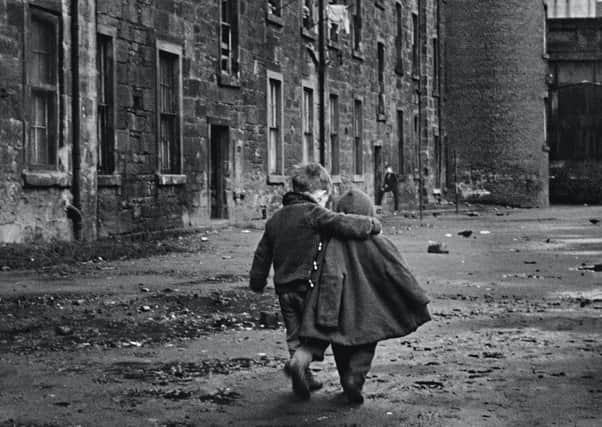Art reviews: When We Were Young | Derrick Guild | James McNaught


It was not easy. Children don’t like sitting still. Exposures of half a minute or more were a challenge to both photographer and child. Where several children are involved it is pretty hard even now to get them all facing the same way long enough to take a useful picture. The first photographic studio established in Scotland was set up on a rooftop above Princes Street by James Howie in 1841. He made daguerrotypes, unique images on a silver plate, and an early example of a mother and her two children already shows one very reluctant child. Nevertheless, there are also great pictures of children from the start. Three years later, Hill and Adamson followed Howie. Their process, the calotype, used a negative to produce a paper print. With its texture, soft light and warm tone, their picture of three children fishing at the minnow pool already seems an authentic glimpse back through time into a golden moment of childhood unencumbered by adult expectations.
Books written for children simply to enjoy without burdensome lessons attached were another wonderful change. Alice in Wonderland and Alice through the Looking Glass are two of its earliest and most enduring monuments. Lewis Carrol (C.L.Dodgson) was also a great photographer of children and he appears here photographing the children of George MacDonald. MacDonald was a friend and he too was a pioneer in the new children’s literature. It was apparently the success the Alice stories had with the MacDonald children that persuaded Lewis Carrol to publish them. To modern eyes, Lewis Carrol’s picture of Irene MacDonald, aged nine or ten, sprawled on a pile of leopard and tiger skin rugs seems just a little dubious. Nevertheless the album does document a fascinating and important alliance in the cause of childhood.
Advertisement
Hide AdAdvertisement
Hide AdJulia Margaret Cameron was a contemporary and she too made great photographs of children. In The Red and White Roses, for instance, two young girls pose rather solemnly with a bunch of flowers. The older one looks warily at the photographer suggesting the distance between child and adult and so implicit respect for the autonomy of the child’s world. Cameron also made a rather beautiful portrait of Lionel Tennyson, son of the poet who was her friend and neighbour.
The Picture Book by Gertrude Käsebier, a photo of a mother and child seated under a tree looking at a book, also reflects new attitudes. Käsebier, an American photographer, was much influenced in her imagery by the ideas of Friederich Froebel, pioneer of the Kindergarten movement.
Later, similar revolutionary ideas, in this case about teaching children with learning difficulties, were introduced by Karl König in Camphill School near Aberdeen. In 1949, Edith Tudor Hart took photographs there for Picture Post. Firmly left-wing, before the war she had already used photography, and in particular pictures of the plight of children, vividly to illustrate social injustice. A hungry girl gazing into the window of a bakery is perhaps her best-known picture, but it loses nothing in force, nor indeed now in topicality, for all its familiarity.
Where she led, others followed. Some of the most memorable pictures from the post-war years are of children in the streets. Bert Hardie’s picture of two boys in the Gorbals taken for Picture Post in 1948 was a telling piece of social realism, but it endures because of the boys’ spirit. Oscar Marzaroli’s Golden Haired Lass has a similar quality. A little girl is silhouetted by a dark doorway as she walks purposefully past. The photographer captures the autonomy even of so small a child. Correspondingly, Larry Herman’s picture of children playing beneath the looming towers of the Red Road Flats conjures the alienating inhumanity of an environment created by good intentions, no doubt, but remote from the humanity that he, Oscar Mazarolli, Bert Hardie, David Peat and others capture in their pictures: the vital energy of children blossoming even in adversity. There is much else in this show to admire, while the story it tells of the evolving relationship of children and the camera and its consequences is both fascinating and important.
Before photography, only the artist could record natural phenomena and there is a rich history of the partnership of art and science and especially with botany and zoology. This has been the starting point for Derrick Guild in his show Brecht’s Journal at the Scottish Gallery. A fine craftsman, he creates pictures of birds, animals and flowers that look as though they were scientific documents from before photography that had served time in class or lecture room, active vehicles in the dissemination of knowledge, not just passive receptacles. His title opens a different perspective on the image, however. Brecht is short for Albrecht Dürer. Dürer was apparently a pioneer of scientific observation, but when Derrick Guild asked a taxidermist to recreate his famous crouching hare, he discovered that it is actually a concoction. Dürer had evidently combined a hare with a rabbit and a cat. Guild explores this in several images. Dürer’s Rhinoceros features significantly too. Science is not always what it seems, but then in actuality, hybridisation can also be very fertile. It seemed natural for Guild to move on to the fantastic hybridised flowers of the great Dutch tulip speculation – and crash – of the 17th century and indeed to give us a mini-monumental sculpture of the humble orange, unexpectedly also a hybrid. It is a fascinating show.
At the Open Eye, nearby, James McNaught also looks to the past to create a charming show that might be called Variations on theme of Paul Delvaux (without the sexy bits). Trams and steam trains power through empty, dreamlike streets, but somehow don’t disrupt the hallucinatory calm. n
*When We Were Young is at the SNPG until 15 April 2018; Brecht’s Journal is at the Scottish Gallery until 28 October; James McNaught, Unreliable Memories, is at the Open Eye until 30 October